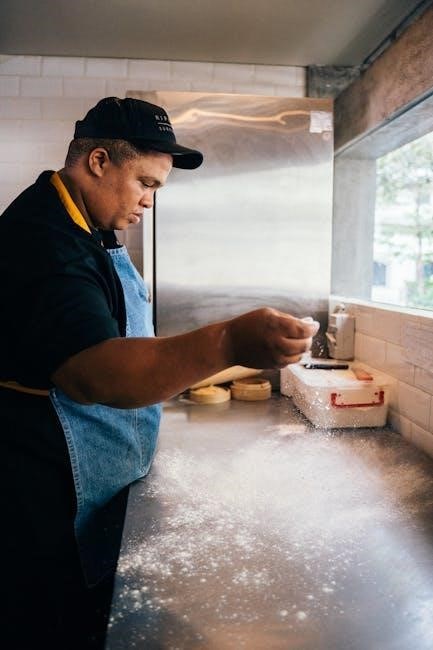restaurant equipment list pdf
A restaurant equipment list is a categorized inventory of tools‚ appliances‚ and safety gear essential for operating a commercial kitchen․ It helps owners‚ managers‚ and chefs identify necessities for launching‚ scaling‚ or updating a restaurant setup‚ ensuring efficiency and compliance with health standards․
1․1 Importance of a Restaurant Equipment List
A restaurant equipment list is crucial for ensuring smooth operations‚ food safety‚ and longevity of investments․ It helps prevent costly breakdowns and safety hazards by organizing essential tools and appliances․ This list streamlines kitchen workflows‚ ensuring all necessary items are available and functional․ It also aids in budgeting‚ maintenance planning‚ and compliance with health regulations․ By having a comprehensive inventory‚ restaurants can avoid downtime and ensure consistent service quality․ Additionally‚ it serves as a valuable reference for future upgrades or expansions‚ making it an indispensable tool for efficient restaurant management and long-term success․
1․2 Purpose of a Restaurant Equipment List PDF
A restaurant equipment list PDF serves as a structured guide for organizing and managing kitchen tools‚ appliances‚ and safety gear․ Its primary purpose is to provide a clear‚ downloadable inventory that helps owners and managers implement maintenance routines‚ track supplies‚ and ensure compliance with health standards․ This document is essential for planning‚ budgeting‚ and ensuring operational efficiency․ It also acts as a reference for staff training and compliance checks‚ ensuring all equipment meets safety and regulatory requirements․ By using a PDF format‚ the list remains accessible and easy to share‚ making it a vital resource for maintaining a well-organized and functional commercial kitchen environment․
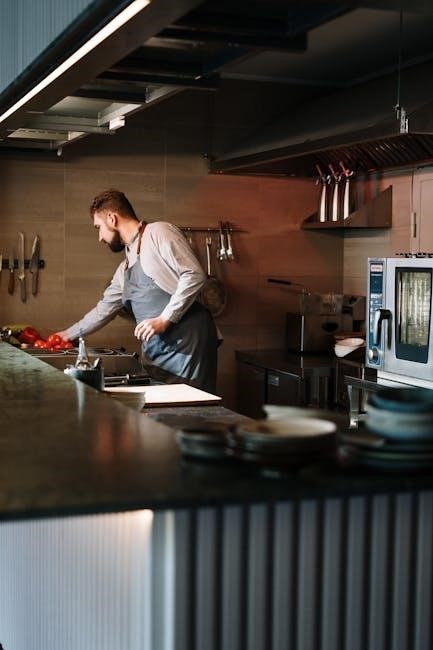
Kitchen Equipment Categories
Kitchen equipment is categorized into cooking‚ refrigeration‚ food preparation‚ baking‚ and smallwares‚ each serving distinct roles in a commercial kitchen setup for efficiency and effectiveness․
2․1 Cooking Equipment
Cooking equipment forms the backbone of any commercial kitchen‚ enabling food preparation and cooking processes․ Essential items include commercial ranges‚ ovens‚ fryers‚ and griddles‚ which handle various cooking methods like baking‚ frying‚ and sautéing․ Microwaves and steam cookers are also common for quick reheating and steaming․ Specialty equipment‚ such as tandoors or pasta cookers‚ may be added based on the restaurant’s cuisine․ These tools ensure consistent food quality‚ efficiency‚ and safety‚ making them indispensable for meeting menu demands and operational needs․ Proper selection and maintenance of cooking equipment are critical for seamless kitchen operations and customer satisfaction․
2․2 Refrigeration Equipment
Refrigeration equipment is vital for maintaining food safety and freshness in a commercial kitchen․ Key items include walk-in refrigerators and freezers for large-scale storage‚ as well as undercounter chillers and reach-in units for quick access․ Ice machines are essential for beverage service‚ while blast chillers rapidly cool cooked foods to prevent bacterial growth․ Proper refrigeration ensures compliance with health regulations‚ reduces waste‚ and preserves ingredient quality․ Each type of equipment serves specific needs‚ from long-term storage to immediate cooling‚ making them indispensable for efficient and hygienic kitchen operations․ Investing in reliable refrigeration systems is crucial for any restaurant’s success and sustainability․
2․3 Food Preparation Equipment
Food preparation equipment is fundamental for efficient meal preparation in a commercial kitchen․ Essential items include knives‚ cutting boards‚ mixers‚ and blenders for chopping‚ mixing‚ and pureeing ingredients․ Food processors and slicers streamline tasks like dicing and slicing‚ saving time and ensuring consistency․ Pots‚ pans‚ and colanders are indispensable for boiling‚ steaming‚ and draining․ Additionally‚ utensils like spatulas‚ whisks‚ and ladles are crucial for various cooking techniques; Selecting durable‚ easy-to-clean equipment ensures hygiene and longevity‚ making food preparation both efficient and safe․ This category forms the backbone of kitchen operations‚ enabling chefs to create high-quality dishes consistently․
2․4 Baking Equipment
Baking equipment is essential for preparing bread‚ pastries‚ and desserts in a commercial kitchen․ Key items include deck ovens‚ rotary ovens‚ and convection ovens for consistent baking․ Mixers‚ such as spiral and planetary mixers‚ are vital for dough preparation․ Dough sheeters and proofing cabinets help in dough processing and fermentation․ Additional tools like baking racks‚ trays‚ and molds are necessary for shaping and storing baked goods․ Small appliances‚ including toasters and waffle makers‚ add versatility․ Selecting durable‚ precise equipment ensures high-quality results and streamlines the baking process‚ making it a cornerstone of any restaurant kitchen focused on baked offerings․
2․5 Smallwares and Utensils
Smallwares and utensils are indispensable in a commercial kitchen‚ ensuring efficiency and precision in food preparation․ Essential items include knives‚ cutting boards‚ spatulas‚ whisks‚ and measuring tools․ Pots‚ pans‚ and cookware are fundamental for various cooking techniques․ Utensils like tongs‚ ladles‚ and peelers aid in handling and prepping ingredients․ Storage containers‚ colanders‚ and strainers maintain organization and hygiene․ Small appliances such as blenders and food processors add versatility․ Selecting durable‚ easy-to-clean utensils ensures longevity and supports a smooth workflow‚ making them a vital part of any restaurant kitchen’s operations and food safety standards․

Front-of-House (FOH) Equipment
Front-of-House (FOH) equipment includes serving tools‚ bar essentials‚ POS systems‚ and dining furniture․ These items ensure smooth service‚ enhance customer experience‚ and maintain operational efficiency․
3․1 Serving Equipment
Serving equipment is crucial for presenting and delivering food and beverages to customers․ It includes items like trays‚ servers‚ and glassware‚ ensuring both functionality and aesthetic appeal․ Durable and easy-to-clean materials are preferred to maintain hygiene․ Trays‚ for instance‚ come in various sizes and designs‚ catering to different service styles‚ from fine dining to casual setups․ Glassware ranges from water and wine glasses to beer mugs‚ each selected to complement specific beverages․ Additionally‚ serving utensils like tongs‚ ladles‚ and serving spoons are essential for efficient plating and portion control․ These tools contribute to a seamless dining experience‚ enhancing both service quality and customer satisfaction․
3․2 Bar and Beverage Equipment
Bar and beverage equipment is essential for crafting and serving drinks efficiently․ Key items include blenders‚ ice crushers‚ and espresso machines for specialty cocktails and coffee․ Beverage dispensers‚ such as beer taps and soft drink machines‚ streamline service․ Bartender tools like shakers‚ jiggers‚ and muddlers are vital for mixology․ Glassware‚ including highball‚ rocks‚ and wine glasses‚ complements drink presentation․ Additionally‚ refrigeration units like under-counter coolers and wine chillers maintain optimal drink temperatures․ These tools enhance the bar’s functionality‚ ensuring quick service and high-quality beverages‚ which are crucial for customer satisfaction and operational efficiency in any restaurant or bar setting․
3․3 Dining Area Furniture
Dining area furniture is crucial for creating a comfortable and inviting atmosphere for customers․ Essential items include tables‚ chairs‚ and booths‚ which come in various styles to suit different restaurant themes․ Lighting fixtures‚ such as pendant lights or sconces‚ enhance ambiance while ensuring proper visibility․ Decorative elements like centerpieces and wall art add to the aesthetic appeal․ Additionally‚ bar stools and high tables cater to casual dining or waiting areas․ Durable‚ easy-to-clean materials are often preferred for high-traffic spaces․ The layout and arrangement of furniture should maximize space efficiency while promoting a pleasant dining experience‚ contributing to overall customer satisfaction and repeat visits․
3․4 Point-of-Sale (POS) Systems
A Point-of-Sale (POS) system is a critical tool for managing restaurant transactions efficiently․ It goes beyond basic cash register functions‚ offering features like order processing‚ payment handling‚ and sales tracking․ Modern POS systems often include inventory management‚ staff scheduling‚ and customer relationship management (CRM) capabilities․ They integrate seamlessly with other restaurant equipment‚ enhancing operational efficiency․ A reliable POS system ensures accurate transactions‚ faster service‚ and better customer experiences․ Key considerations include scalability‚ user-friendliness‚ and integration with accounting software․ Investing in a robust POS system helps streamline operations‚ improve profitability‚ and maintain smooth workflow during peak times․ It’s essential for modern restaurants to stay competitive and organized in a fast-paced environment․
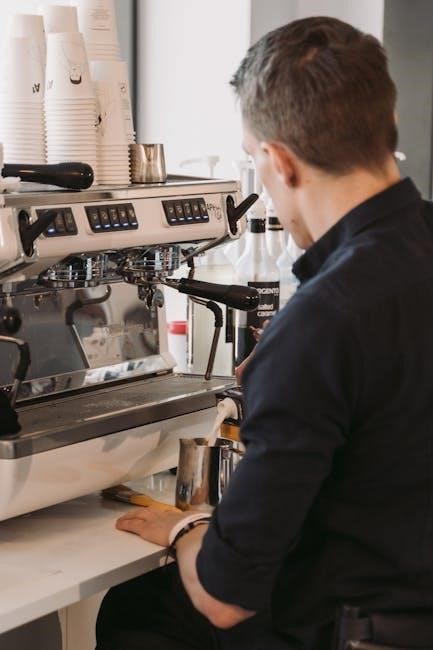
Cleaning and Maintenance Equipment
Cleaning and maintenance equipment are essential for maintaining hygiene‚ safety‚ and functionality in a restaurant․ This includes vacuums‚ scrubbers‚ sanitizers‚ and waste management tools to ensure a clean environment and prolong equipment lifespan․
4․1 Sanitation Supplies
Sanitation supplies are crucial for maintaining hygiene and safety in a restaurant․ Essential items include disinfectants‚ gloves‚ scrub brushes‚ mops‚ and cleaning solutions․ These tools help prevent contamination‚ ensuring a clean environment for food preparation and compliance with health regulations․ Regular use of sanitation supplies protects both staff and customers from potential health risks․ A well-stocked supply of cleaning materials also supports efficient daily operations and prolongs the lifespan of equipment․ By prioritizing sanitation‚ restaurants can uphold high standards of cleanliness and safety‚ which are vital for their reputation and success․
4․2 Waste Management Equipment
Waste management equipment is essential for maintaining cleanliness and efficiency in a restaurant․ Key items include trash cans‚ recycling bins‚ compost containers‚ and waste compactors․ Proper disposal systems help prevent contamination and pests‚ ensuring a hygienic environment․ Dumpster systems and waste sorting tools also play a crucial role in organizing and managing waste effectively․ These tools optimize space and streamline waste removal processes․ Regular use of waste management equipment supports environmental sustainability and compliance with local regulations․ By investing in reliable waste management solutions‚ restaurants can reduce operational challenges and maintain a clean‚ safe environment for both staff and customers․ This equipment is vital for smooth daily operations and long-term sustainability․
4․3 Maintenance Tools
Maintenance tools are crucial for ensuring the longevity and functionality of restaurant equipment․ Essential items include wrenches‚ screwdrivers‚ pliers‚ and Allen keys for repairs․ Cleaning supplies like brushes‚ scrubbers‚ and degreasers help maintain hygiene and prevent equipment breakdowns․ Toolkits should also include multimeters for electrical diagnostics and leak detectors for refrigeration systems․ Regular use of these tools prevents equipment failure and ensures safety․ Additionally‚ having a supply of spare parts‚ lubricants‚ and seals on hand can minimize downtime․ Proper maintenance tools empower staff to address issues promptly‚ reducing the need for costly repairs and ensuring smooth restaurant operations․ They are vital for maintaining efficiency and safety in a busy kitchen environment․

Essential Restaurant Equipment Checklist
A comprehensive restaurant equipment checklist ensures all necessary appliances and tools are available․ Key items include walk-in refrigerators‚ commercial ranges‚ fryers‚ dishwashers‚ and baking ovens․ These essentials are vital for efficient kitchen operations and food safety․
5․1 Must-Have Items for Commercial Kitchens
A well-equipped commercial kitchen requires essential items to ensure smooth operations․ Walk-in refrigerators and freezers are crucial for storing perishables․ Commercial ranges‚ fryers‚ and ovens are fundamental for cooking․ Dishwashers and food processors streamline cleaning and prep work․ Bakeware and cookware are necessities for diverse menu offerings․ Smallwares like knives‚ pots‚ and utensils are indispensable․ These items form the backbone of any professional kitchen‚ ensuring efficiency‚ safety‚ and consistency in food preparation․
5․2 Optional but Useful Equipment
While not essential for every kitchen‚ certain equipment can enhance efficiency and versatility․ For cloud kitchens‚ items like a two-burner gas range or dosa bhatti are beneficial․ Fast-food restaurants might opt for microwaves or soft drink dispensers․ Specialty equipment‚ such as sous vide machines or blast freezers‚ can elevate menu offerings for fine dining․ Additionally‚ convection ovens and mixers are valuable for bakeries or restaurants with extensive dessert menus․ These optional items can streamline operations or cater to specific culinary needs‚ making them worthwhile investments for restaurants looking to expand their capabilities or cater to niche markets․
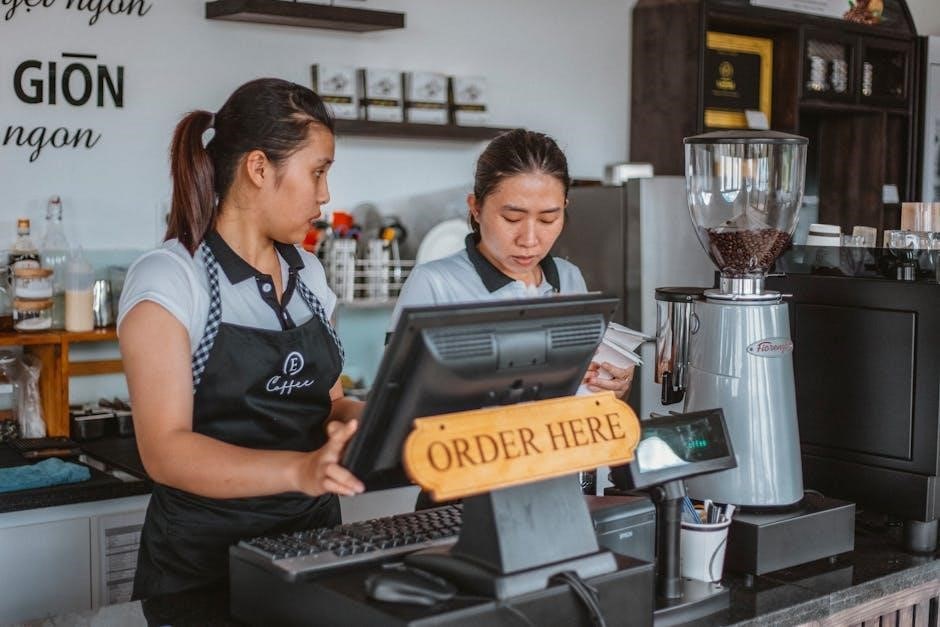
Budgeting for Restaurant Equipment
Budgeting for restaurant equipment requires careful planning‚ with costs ranging from $30‚000 to $100‚000 for back-of-house items‚ depending on the restaurant’s size and specific needs․
6․1 Estimating Costs
Estimating costs for restaurant equipment involves assessing the type‚ quality‚ and quantity of items needed․ Essential items like commercial ranges‚ fryers‚ and refrigerators can range from $30‚000 to $100‚000 for back-of-house equipment․ Prioritize must-have items and consider both new and used options to stay within budget․ Research suppliers for competitive pricing and warranties․ Additionally‚ factor in installation‚ delivery‚ and maintenance costs․ A contingency fund of 10-20% is recommended for unexpected expenses․ Detailed planning ensures resource allocation aligns with your restaurant’s specific needs and avoids financial strain․
6․2 Tips for Saving Money
Saving money on restaurant equipment involves strategic planning and smart purchasing decisions․ Consider buying refurbished or used equipment‚ which can significantly reduce costs while maintaining functionality․ Research suppliers offering discounts or bundle deals․ Prioritize energy-efficient appliances to lower long-term utility expenses․ Lease options can also help conserve initial capital․ Additionally‚ focus on essential items first and gradually invest in optional equipment as your business grows․ Regular maintenance can extend equipment lifespan‚ avoiding premature replacements․ By balancing quality and cost‚ you can optimize your budget and ensure your restaurant operates efficiently without compromising on necessary tools․
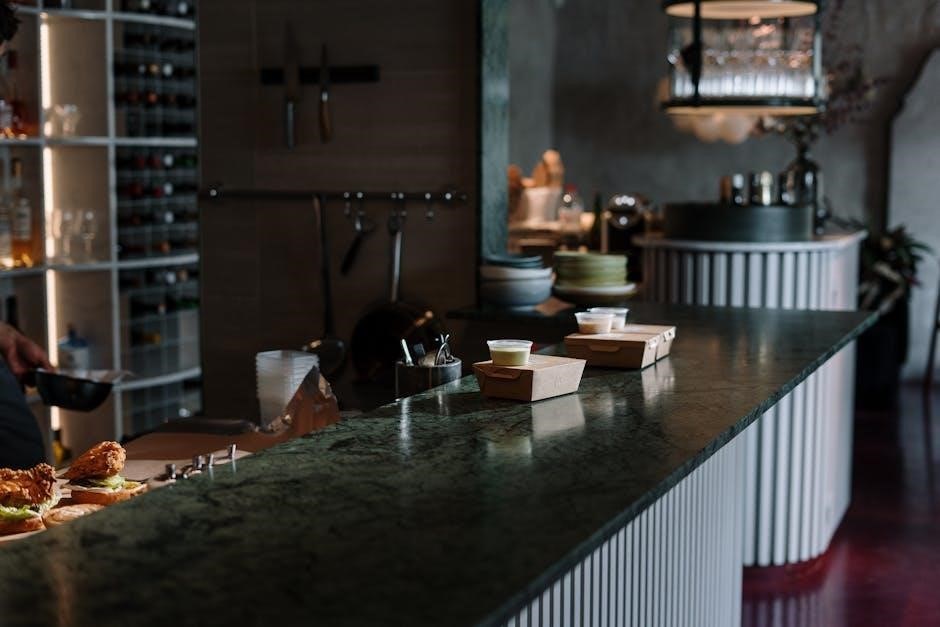
Supplier and Vendor Considerations
Choose suppliers with a proven track record for reliability‚ offering durable and cost-effective solutions․ Ensure they provide warranties and after-sale support to maintain your equipment effectively․
7․1 Choosing Reliable Suppliers
Selecting dependable suppliers is crucial for acquiring high-quality restaurant equipment․ Look for suppliers with a history of positive reviews and testimonials from other restaurants․ Ensure they offer warranties and after-sale support to address any maintenance or repair needs․ Reliable suppliers often provide detailed product specifications‚ helping you make informed decisions․ Additionally‚ consider their ability to deliver equipment promptly and their willingness to offer customization options․ A trustworthy supplier will ensure your restaurant runs smoothly‚ with minimal downtime and optimal performance․ Prioritize suppliers who understand your specific needs and can provide tailored solutions for your kitchen setup․
7․2 Warranties and After-Sale Support
When purchasing restaurant equipment‚ ensuring robust warranties and reliable after-sale support is essential․ Warranties protect your investment by covering repairs and replacements for faulty or damaged equipment‚ minimizing unexpected costs․ Look for suppliers offering comprehensive warranty periods and clear terms․ After-sale support‚ such as technical assistance and maintenance services‚ ensures equipment longevity and optimal performance․ Reliable suppliers often provide dedicated customer service teams to address issues promptly․ Prioritize brands with strong reputations for honoring warranties and delivering consistent post-purchase support․ This ensures your restaurant operates smoothly‚ with minimal downtime and prolonged equipment lifespan․
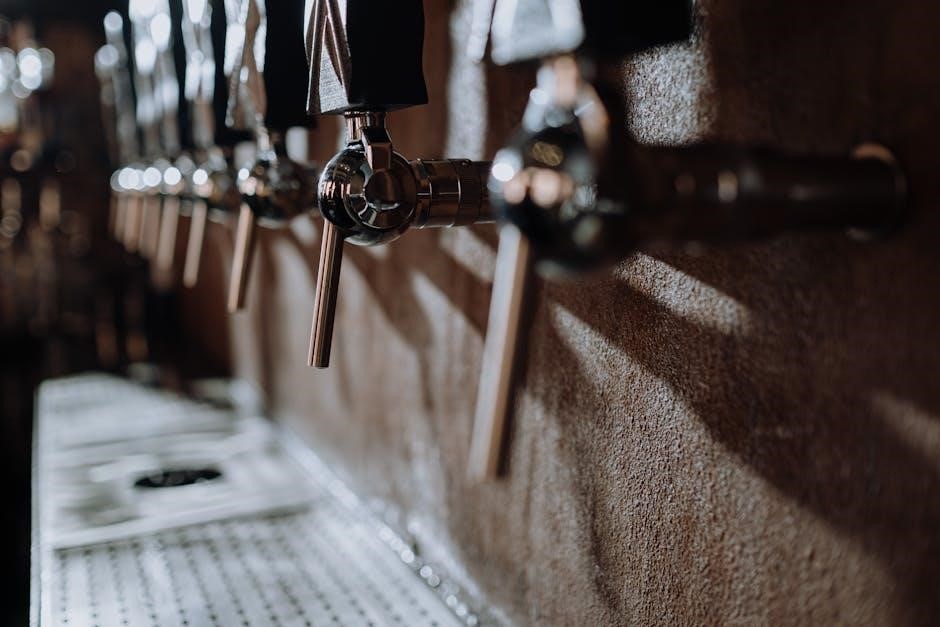
Health and Safety Compliance
Health and safety compliance ensures your restaurant meets essential safety standards and regulatory requirements‚ protecting customers‚ staff‚ and your business from potential health hazards and legal repercussions․
8․1 Equipment Safety Standards
Equipment safety standards are crucial to ensure appliances function safely‚ reducing risks of accidents and ensuring compliance with legal requirements․ These standards often include certifications like NSF International and UL‚ which verify equipment meets safety criteria․ Commercial kitchen equipment must adhere to specific guidelines for electrical‚ gas‚ and fire safety to protect staff and customers․ Regular inspections and maintenance are essential to uphold these standards․ Non-compliance can lead to equipment malfunctions‚ injuries‚ or even restaurant closures․ Always choose equipment that meets recognized safety standards to maintain a secure and efficient kitchen environment․ Compliance ensures long-term operational safety and avoids potential legal or financial repercussions․
8․2 Regulatory Requirements
Regulatory requirements ensure that restaurant equipment meets health‚ safety‚ and environmental standards․ Restaurants must comply with local health codes‚ fire safety regulations‚ and food safety guidelines․ Equipment must be certified by recognized bodies to ensure it meets these standards․ Non-compliance can result in fines‚ penalties‚ or even closure․ Additionally‚ restaurants must obtain necessary permits for equipment operation․ Regular inspections by health and safety authorities are common to verify compliance․ Adhering to these regulations is crucial for maintaining operational legitimacy and ensuring a safe environment for both staff and customers․ Failure to meet requirements can lead to legal consequences and damage to the restaurant’s reputation․

Customizing Your Equipment List
Customizing your restaurant equipment list ensures it aligns with your menu‚ restaurant size‚ and operational needs․ A comprehensive checklist helps organize and select the right tools and appliances for efficient kitchen operations․
9․1 Tailoring to Your Menu
Tailoring your restaurant equipment list to your menu ensures that every dish is prepared efficiently․ For example‚ a bakery requires specific ovens and mixers‚ while a steakhouse needs high-quality grills․ By matching equipment to menu items‚ you optimize performance and reduce unnecessary expenses․ A well-structured checklist helps identify must-have items‚ such as fryers for fried dishes or pasta cookers for Italian cuisine․ This approach ensures your kitchen is equipped to deliver consistent quality‚ meeting customer expectations and streamlining workflows․ Regularly updating the list as your menu evolves keeps your operations aligned with culinary goals․
9․2 Adjusting for Restaurant Size
Restaurant size significantly influences the scale and complexity of equipment needed․ Smaller restaurants may require compact appliances and multi-functional tools to save space‚ while larger establishments can accommodate heavy-duty‚ specialized equipment․ Adjusting your equipment list based on size ensures efficient use of available space and resources․ For example‚ a small café might prioritize a single commercial oven‚ whereas a large restaurant could invest in multiple ovens and specialized cooking stations․ Budget considerations also vary‚ as larger spaces often require higher capacity equipment‚ increasing initial investment․ Regularly assessing your restaurant’s size and layout helps optimize equipment selection‚ ensuring a balanced and functional kitchen environment․
A well-organized restaurant equipment list ensures efficiency‚ prevents costly breakdowns‚ and supports food safety and investment longevity‚ making it a cornerstone of successful restaurant operations and planning․
10․1 Final Tips for Building Your Restaurant Equipment List
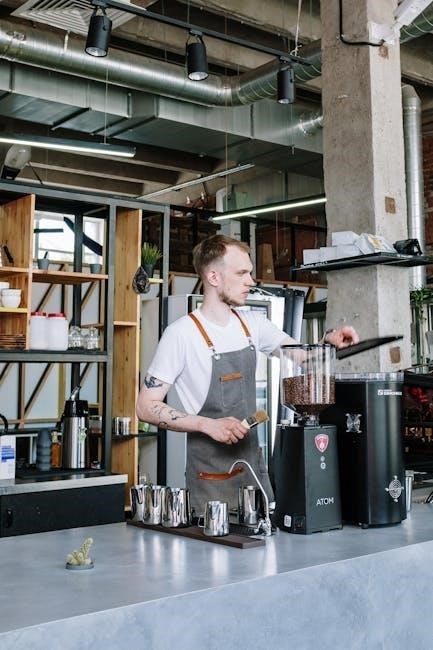
Creating a comprehensive restaurant equipment list is crucial for efficiency and safety․ Start with a detailed checklist‚ prioritizing essential items like commercial ranges‚ refrigerators‚ and smallwares․ Consider scalability based on your menu and restaurant size․ Budget wisely‚ balancing quality and cost‚ and explore options for pre-owned equipment․ Regularly update your list to reflect operational changes and maintenance needs․ Finally‚ consult professionals to ensure compliance with health and safety standards․ By following these tips‚ you’ll ensure your restaurant runs smoothly‚ adheres to regulations‚ and supports long-term success․
10․2 Importance of Regular Updates
Regularly updating your restaurant equipment list is essential for maintaining smooth operations and ensuring safety․ Outdated lists can lead to overlooked maintenance‚ compliance issues‚ and inefficiencies․ Stay informed about new technologies and equipment advancements to keep your kitchen up-to-date․ Updates also help address changes in menu offerings‚ dietary trends‚ or restaurant expansion․ Additionally‚ regular reviews ensure that all equipment meets current health and safety standards‚ reducing risks of breakdowns and potential legal issues․ By periodically revising your list‚ you can adapt to evolving needs‚ optimize performance‚ and ensure long-term success in a competitive industry․
